Marketing and sales pros often fear that premium pricing – or charging more for your product than your competitors charge for a similar product, will deter customers – but sometimes the opposite is true!
Transcript – Premium Pricing to Qualify Prospects
Paula Williams: Welcome to aviation marketing Hanger Flying episode number 43, Premium Pricing to Qualify Prospects. I’m Paula Williams.
John Williams: And I’m John Williams.
Paula Williams: And we are ABCI, and ABCI’s mission is.
John Williams: To help you ladies and gentlemen sell more products and services in the aviation world.
Paula Williams: Absolutely, so you may have questions or comments about pricing your products or about premium pricing in the aviation industry, or about anything else for that matter.
You can tweet using the #AvGeekMarketing or use Instagram or Facebook, and we will do our best to find your comments and comment on them. You can also comment on our blog, but lots of ways to get in touch with us, right, John?
John Williams: Absolutely.
Paula Williams: All right, cool, so why qualify prospects?
John Williams: Ha.
Paula Williams: [LAUGH]
John Williams: Save yourself time and money.
Paula Williams: Why not just sell to everybody with a pulse and a checkbook, right?
John Williams: Well, that would be fine if sales were actually made.
Paula Williams: Well, that’s not necessarily true because sometimes you’ll end up with a customer you don’t want.
John Williams: Yeah, depends on the product.
Paula Williams: Exactly, so the reason that we want to qualify prospects is because in the sales process we often end up wasting a lot of time with time wasters and tire kickers, right?
John Williams: You make a sales pitch to somebody that’s not qualified to buy, you just wasted your time and money.
Paula Williams: Exactly, and in aviation a lot of times we actually fly out to see people to make sales pitches or to further the sales process. And if someone does not qualify, we’ve just wasted a lot of time and money.
John Williams: Yes.
Paula Williams: Absolutely, okay, so the first reason we want to qualify prospects is to get rid of those time wasters and tire kickers.
The other thing is that while we are chasing these time wasters and tire kickers, we’re spending time that we could be using to better refine our list or to track down people who are really qualified. And we may be missing some better opportunities because our competitors are spending their time more wisely than we are [LAUGH] .
If we’re spending all of our time flying out to see crazy people who have no intention of buying from us, right?
John Williams: Or are not authorized to spend the money to purchase
Paula Williams: Which is a lot more likely, exactly, people who are maybe too low on the totem pole or have a completely unsuited situation or whatever.
What is even worse is when you accidentally make a sale to someone who is not a good customer for you. Aviation is a small world. We really can’t afford to have an unhappy customer. So if you make a sale to someone who’s not a good fit for your product or service, then you end up spending an awful lot of time and money trying to make that person happy.
Or trying to mitigate the damage of having an unhappy customer who is maybe putting bad reviews online, or talking to people in a way that makes it sound like your product isn’t any good, when maybe it just wasn’t a good fit, right?
John Williams: Customer service is a necessary thing, but customer service to the wrong client can be very expensive.
Paula Williams: Right, this is where Perry Marshall’s 80/20 rule comes into play. Sometimes if you see that you’re spending 80% of your customer service time on 20% or less of your customers, you may want to look at that and say, those people may not be the best fit. These kind of people may not be the best fit for our product or service.
Maybe we’re working a little too hard to make a round peg fit into a square hole, right?
John Williams: Mm-hm.
Paula Williams: Cool, and the last one is deals that will never close. If you’re a salesperson, I know you’ve heard this story before [LAUGH]. There have been people that we’ve had in our sales pipeline forever, until we started being a little bit more disciplined about qualifying customers, where it seemed like a good fit, and it seemed like a good fit, and it seemed like a good fit, and just month after month, there was one thing after another that just was imminent.
The sale that we thought was imminent really wasn’t, and that’s kind of a drain on resources and time and attention and everything else. So that’s another reason that we really want to do a good job of qualifying customers, so we don’t end up with those deals that are 99% done for months at a time, right?
John Williams: Yep.
Paula Williams: All right, so how,
Paula Williams: Do we qualify customers? There are a lot of things that we can do, among them money, authority, and need, right?
John Williams: Yep.
Paula Williams: So money is pretty obvious. The authority is not so obvious, and the need is usually the first thing that people that we screen for when we’re looking for customers.
So when we’re doing inbound marketing, then the want or the need is something that becomes obvious. Obviously, they found us online. They requested some information, so they have a want or a need. It may be more of an interest than a want or a need, so that does require some qualification, but that’s usually the first thing we find out, right?
John Williams: Yep.
Paula Williams: Okay, so the next thing we look for is, is this a person who is in a situation where they would have the authority to make a purchase? And we can look at their job description, we can look at the size of company that they have, we can look at the types of aircraft they fly, we can look at a lot of different things to see if it looks like they have the authority to make this kind of a purchase.
And in a lot of cases you can do this by asking some questions, right?
John Williams: Yes, but don’t ask them if they have the authority because they will probably say yes
Paula Williams: [LAUGH]
John Williams: Just to go through the sales process. You know what, we need to make this presentation to my boss.
Paula Williams: Exactly, and you can go through a whole lot of the sales process before finding out that you’re going to have to do it all over again because the person that you’ve presented to was not the right guy, or was too far down the totem pole. The other thing that can happen when you present too far down the totem pole is that you’re actually in the sales prevention department, right?
John Williams: Hm, yes.
Paula Williams: These are people who have no intention of buying your product or service, they just want to know what’s out there, and want to know how they can replicate it for themselves internally so that they can keep their boss happy. And you’re just teaching them to do your job, right?
John Williams: It is a fine line.
Paula Williams: There is a fine line. So you need to give them enough information to be interested in promoting you up the ladder, but there are some questions that you can ask that will really help you with this besides, do you have the authority to make this purchase?
Because nobody’s ever actually going to ask that, right?
John Williams: And if they do, you never know if you get the correct answer.
Paula Williams: Exactly, so some of the things that you could ask are, so who’s involved with decisions of this kind? Who else do we need to involve in this conversation?
How many copies of our presentation material should I bring? We like to include everyone and make sure everyone has their own copy. So these are some kind of less obnoxious ways of finding out if the person that you’re talking to has the authority to make a decision. At some point in the sales process, especially before you invest money going somewhere or creating some really expensive materials, you really do have the right and the responsibility to ask these kinds of questions.
Who will be making the purchase decision, or when are you in the market to be looking at solving this problem? And there are some smoother and some rougher ways of asking that question, but it does need to be asked and answered before you spend too much money on the sales process, right?
John Williams: Yes, and no is a good enough answer. You just need to find out what it is.
Paula Williams: Exactly, so if you ask someone, who all is going to be involved in this decision process? And they say well, it’s just going to be me, then you can say well, is there anybody that advises you in this process?
And then that often drags out another answer. You can also say things like, so if we were to be able to answer all your questions and solve all your problems, when would you be looking at making a purchase? Because I know some people have budgets that they have to comply with, and there may be the beginning of the month, or the quarter, or the year that would be better for you.
And it’s fine to ask that early in the sales process so that you’re getting the right answer.
John Williams: And is there anybody else that should listen to this presentation?
Paula Williams: Exactly.
John Williams: Just to get coverage in the company.
Paula Williams: Mm-hm, or outside the company. I mean, sometimes people will want to include an outside expert or somebody like that, that just by being open to that, and it sounds like you’re being super accommodating in the sales process, and super helpful in the sales process, when really you’re protecting your interests in qualifying the customer, right?
John Williams: Yes.
Paula Williams: Okay, cool, so the other thing is money, and money is a little bit harder to determine than authority. Of course, if it’s a public company you can look at their annual reports and other kinds of things to see how big their budgets are. If they are not a public company, and most companies in aviation are not, then it’s going to be more along the lines of they may have some references.
Aviation’s a really small world, so If somebody’s not paying their bills, you’ll often here about it, [LAUGH] for better or for worse. But there are also some services that you can use to run a really inexpensive credit check or background check on people before you get too far in the sales process.
And they should be expecting that, especially if it’s large ticket item, just to make sure that they really do have the means to make the purchase.
John Williams: And it varies with the cost of the particular product. You’ll have the letters of credit for anything in a certain level and up and so forth, so there’s lots of stuff involved in that, but necessary to go through.
Paula Williams: Right, and what’s interesting is most people in the aviation industry don’t do credit checks soon enough in the sales process. But you need to let your prospect know that you’re spending money traveling to see them and making presentations and other kinds of things, and devoting a lot of time and energy to this process.
So it is perfectly acceptable to ask to do a credit check before you get too far into the process. Don’t you think, John? Are you ever upset by that?
John Williams: I don’t know if I’d ask for a credit check.
Paula Williams: Okay.
John Williams: Not right up front.
Paula Williams: Yeah, so how would you do it?
Not right up front, but at some point in the process, how would-
John Williams: Well, it depends, I mean if they’re going to pay cash, then why do you need a credit check?
Paula Williams: Good point.
John Williams: If your product requires them to use a payment where you’re billing them monthly, then maybe, and that’s a fine line to walk.
You don’t want to upset them and tell them to go away.
Paula Williams: [LAUGH] That’s true.
John Williams: By saying we’re going to do a credit check on you, he’ll say well, why?
Paula Williams: Right, but before you make your second trip to visit somebody who’s a potential client, before you spend x amount of money in the process, would you have a line at which you would run a credit check?
John Williams: Yeah, if I’m selling a jet, that’s not a credit check. Well, it’s sort of a credit check, you need to get a letter of credit.
Paula Williams: Right.
John Williams: But that just says you have the money in there to be paid.
Paula Williams: Okay, but software, shop equipment, other kinds of things, components.
John Williams: I don’t know. They’re either going to pay by credit card, wire, ACH transfer, or cash. Probably not cash, so they’re going to pay one of those other ways, and it’s got nothing to do with their credit. Either they can or they can’t.
Paula Williams: Okay, cool, well, you have two different opinions there.
I think if you’re spending a lot of time visiting a client and spending a lot of time on site doing inspections and other kinds of things to see if your product is a good fit and things like that, then there is a point at which you do want to make sure that they have the means to make the purchase.
All right, so premium price strategy. There are a lot of companies that do this very, very well, and here are three examples. I wish they were all in the aviation industry, but they’re not. First, of course, is Apple. Apple almost never discounts their product until they have a new [COUGH] version of their product coming out.
So for example, if you have an iPhone, whatever the latest version is, and they’re coming out with a new iPhone next month, then you may see some discounts on that. But otherwise, they almost never discount their product, and they are almost always more expensive than every other product in that category, right?
Now that gives them a lot of marketing leverage. If you remember the old game show the Price is Right, I don’t know if you remember that one, but they would always try to bid $1 more than the other person, so that they would have the entire space of everything above $101.
So if the product costs $100, or $101, or $105, or 300, or $1,000, they would be the closest bidder, right? You know what? They had a rule that it had to be the closest price without going over.
John Williams: Okay.
Paula Williams: But in real life, we don’t have that rule.
So if you are asking too much for your product, it’s going to do one of two things. Either they have exactly $100 budgeted for this item, and you’re asking $101, they’re either going to expand their budget if they want it badly enough, or they’re going to go with the cheaper, the competitor, in which case they’re going to reduce their expectations and everything else.
So I think the best place to be is the slightly, by a thin margin, the most expensive product in any particular category because that gives you the most defensible space. Do you agree, John?
John Williams: Probably.
Paula Williams: [LAUGH] Probably, okay. So Apple does that really well, and their sales are fantastic, even in countries and places where you think the demographics wouldn’t support it.
There are people who will give up any number of other things in order to have this product because it is seen as a premium, it has a reputation for being excellent, it is easier to use, and is better designed than the other products in that category. So you have to have quality to support it, but I think that is a very defensible place to be.
John Williams: Mm-hm, absolutely.
Paula Williams: Another one that has done a really good job with this is the Disney Parks. Disney has a lot of discounted merchandise and other kinds of things in, you can find-
John Williams: Inside the park
Paula Williams: Yeah, I mean or outside the park. I mean, you can go to any shopping mall or any street corner and find a Disney shirt for $4 or something like that.
So, I mean there’s a lot of discounting that is done with Disney merchandise, but their parks are another story entirely. They have different price points for family passes and other kinds of things, and then they also have their VIP passes, where you can bypass the lines and get special services, breakfast with the Disney characters and other kinds of things.
So they do a lot of different bracketing of their prices. But whenever there’s a question about the quality of the Disney Parks and things like that, for example, last year they had the measles outbreak, and so a lot of people were questioning should I take my kids [COUGH] to a Disney Park and be amongst all these other kids?
And Disney’s response to that was actually to raise their prices. I thought that was crazy at first, and then brilliant after thinking about it. Because it wasn’t a financial decision to consider whether or not to take your kids to a Disney park that year, it was a health consideration.
So most parents will do just about anything to keep their kids safe. And so, if they know that Disney is, or if they think that Disney is going to have fewer people because they’ve just raised their prices, and also that they’re going to be more selective about the people that are in the parks and so on.
Because of that, it causes a thing called expensive, it’s reassuringly expensive. If you buy a Rolex, you expect to pay a certain price. If you want to take a really high quality vacation with your kids, you expect to pay a certain price. And the discounting actually doesn’t help that because people have associated discounts in their mind with low quality, and crowds, and poor experiences, and terrible vacations, right?
[LAUGH] So, Disney Parks, I think, is doing a fantastic job with that, and that also gives them the money to do things like the wristbands that they’re experimenting with and other things that make the experience better. Whether keeping tracks of lines and managing traffic within the park better.The other thing is Cessna. Now you have some experience with Cessna never discounting their products.
John Williams: [LAUGH] Yeah, well, having purchased two new 172s for the company, each year they raise the prices on those things. I mean, well, they’re way too expensive to buy new now. I mean, it just doesn’t make any sense.
For the same amount of money, you can get different aircraft, but it depends on what you’re going to use it for.
Paula Williams: Exactly.
John Williams: Nonetheless, they keep raising prices. But if you push them, they will find a reason to discount it to you, and that’s what I did in both instances.
So I got a better deal than a new price on each other.
Paula Williams: So having a high price gives you the room or the leverage to give discounts for various reasons either for-
John Williams: Well yeah, when you buy the second one of anything that large they look at you more favorably.
Paula Williams: Right, that’s true. Or you can give discounts for seasonal discounts, things by the time of year, for referring other customers, for any number of things that you can offer a discount for that makes sense, if your price is high enough to begin with. Otherwise, you don’t have the margins to do that, right?
John Williams: Right.
Paula Williams: Okay, so the main thing that we’re looking at here is price versus value, and most people, until we’ve worked with them for a while, they think price until we kinda push them to think value. And so, high end shoppers, high net worth and ultra-high net worth individuals, and also lot of decision makers for organizations are a lot more interested in value than they are in price, and those are the people that are better customers to begin with.
You want people who are considering what’s the business value of what I’m buying as opposed to counting every single penny. And for a lot of folks this is a paradigm shift, and it sounds hokey but it’s absolutely true. You need to think in terms of what value does my product bring to this customer, as opposed to charging a price that is equivalent or a little bit less than the competitors?
Which is what everybody seems to try to do is get into these races to the bottom, which are disastrous for everyone.
John Williams: Yep, they certainly are.
Paula Williams: All right, so here are some ways that you can make that paradigm shift and start thinking about value instead of price.
One thing is that customers who are kind of the value-centered are people that are going to hold you to a higher standard. So that is a good and a bad thing. It will make your company better if you charge a premium price because your customers are going to expect better service, they’re going to expect better quality.
All of those things are part of the deal when you charge a higher price. Customers who are, what I’m going to consider value customers as opposed to price customers, are people who aren’t spending their very last dime on your product. So they have the means to implement your product better.
In our case, where we sell aviation consulting and things like that, a lot of times people will spend a lot of money on our consulting services, and then not have any money left over to do some of the things that we advise them to do. So we try to stay out of those kinds of situations, and we actively discourage some customers from purchasing some of our products and services because they don’t have the means to implement them well.
And you may run into that situation as well. Premium prospects are more satisfied with the result, weirdly, and this is something that was explained to me probably best when my son was doing Tai Kwon Do. And we did lessons at a community school kind of a situation, where they were really casual about the lessons and everything else.
And they did the same exact curriculum at some of the more expensive schools. A few years later, I was in a different situation, where I was able to afford a really good Tai Kwon Do school that was also having kids participate in the Junior Olympics and other kinds of things.
And it was the exact same curriculum, but they were really strict on the uniforms, they were really strict on the rules. They were very,
Paula Williams: Had a different expectation of us, and we had a different expectation of them, because we were paying more money. And that was really one of the factors that made a bigger difference than it probably should have, when you think about it logically.
But could they have enforced things more rigidly in a less expensive situation? Probably not, because it would turn off their demographic and people would just go away, as opposed to taking these inexpensive classes. But when you are paying more money for something, you expect more of yourself in using that product, and you also expect more from the people providing that product, right?
John Williams: Yes.
Paula Williams: Okay, they are more likely to have colleagues with the means to purchase your product, so high net worth and ultra-high net worth people tend to hang out with others in the same strata. So you can call that whatever you like, but the reality of it is that they do refer one another more frequently.
And the last point is that they are more fun. [LAUGH] We really enjoy working with people who put a lot into it and expect a lot out of it, and get more out of our products and services than they would otherwise. So every time we raise our prices, we find that all of these things work a little bit more in our favor.
It scared me to death the first time we did it, but now we raise prices almost every year. Not on our existing customers, but on new customers, and we’re really usually happy with the result.
John Williams: So far.
Paula Williams: So far, exactly. Okay, so the motto for this episode, if you walk away with one thing, is you price high and justify, right?
John Williams: Absolutely.
Paula Williams: Easy to remember easy, not so easy to do but-
John Williams: No, it’s not that difficult. All you have to do is think about your product and what it does for people and see what the value is, and then as long as there’s value added to somebody then it becomes a no brainer.
Paula Williams: Absolutely, so when we bring that back to prospecting, it’s going to attract a different kind of prospect to you than a lower price.
John Williams: Yes, and that’s the whole point. You price high, put your marketing in step with your price, and then you draw in a different demographic, and that’s really what you want.
Paula Williams: Exactly, so you hold yourself and your team accountable to a higher standard because of that. All right, so here’s some methods to implement. The first thing is that you’re going to have to upgrade your customer service experience, right?
John Williams: Yeah, no kidding.
Paula Williams: If you’re paying more for a product, you expect more out of it.
And I think one of the big differences is like American Express versus almost any other financial services company that we’ve worked with. They have a different set of, I don’t know if it’s scripts or if it’s procedures or what it is. But when you talk on the phone with American Express, it is really obvious, they thank you specifically for your loyalty, and your purchases, and your history.
They spend as much time on the phone with you as they need to to solve your problem. They do a lot of things that are completely different than a lot of financial services companies. Would you agree?
John Williams: Yeah, we’re out here selling American Express, but they do have a great customer service.
Paula Williams: Yeah, and that’s a good example. We’re going to also talk about some other customer service examples in later podcasts, but that’s one thing to think about. Another thing is high end design of your marketing materials. People who are going to be paying more money expect to see a higher quality of materials as part of that experience.
You’re going to want to narrow your prospect list by the finances, having the ability to afford it, but you’re also going to want to narrow your prospect list because they expect a higher degree of personalization. So people in this list do not want to see something, a direct mail package that says Dear Customer, or Dear Airplane Owner.
They want something that is specific to their aircraft make and model, ideally to their tail number. And tell them something that is very specific to them and you’re not wasting their time with general information.
John Williams: A few years ago there was a story floating around about a gentleman that got tired of saying Dear Customer.
So he said okay, I want to buy this product, and he wrote the check out to Customer and signed it.
Paula Williams: [LAUGH]
John Williams: To the company and signed it as customer.
Paula Williams: As customer, exactly. So you have to treat your customers like human beings if you’re going for the high end.
More personalization. We just talked about some of those things. All right, so download our pricing tip sheet, Pricing Strategies for Aviation Products and Services, and that is available at ABCI1.com/Pricing. That’s Alpha, Bravo, Charlie, India, number 1, dot com, forward slash pricing. And that has some of our pricing philosophy and other things that you can do to help set a price that you’re going to be comfortable with, and make things work for you.
All right, some things that you may also want to see to learn more about pricing strategies. Episode 19 goes into detail about a pricing strategy book in Dan Kennedy’s line of books that’s pretty good, and I give some examples from that. Another one to listen to, learn more about qualifying prospects, that’s Episode number 17.
So that’s where we talk in more detail about qualifying techniques and other kinds of things. Narrowing your prospect list, Episode 44, which is coming soon, right after this one. So, go sell more stuff.
John Williams: Yep, America needs the business.
Paula Williams: Subscribe to our podcast on iTunes, Stitcher, or Google Play, and please do leave us a review.
John Williams: Okay, you get to this part and re-recording, you went too far.










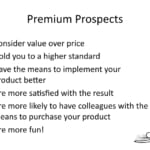
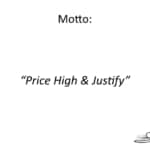
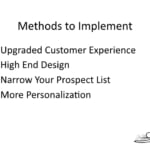
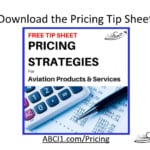
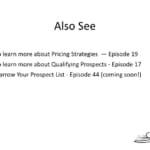







Leave A Comment